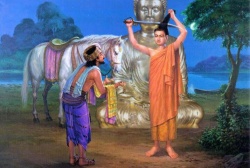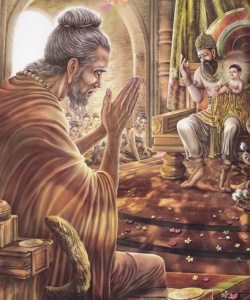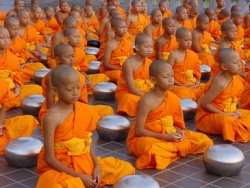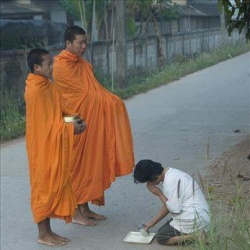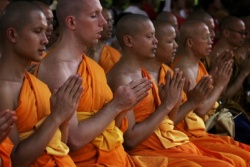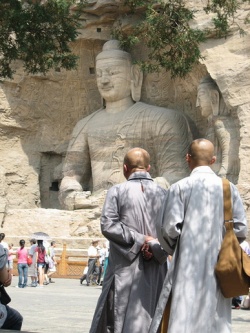Upāsaka and Upāsikā
Click here to see other articles relating to word Upāsaka and Upāsikā
Upāsaka (masculine) or Upāsikā (feminine) are from the Sanskrit and Pāli words for "attendant".
This is the title of followers of Buddhism (or, historically, of Gautama Buddha) who are not monks, nuns, or novice monastics in a Buddhist order, and who undertake certain vows.
In modern times they have a connotation of dedicated piety that is best suggested by terms such as "lay devotee" or "devout lay follower."
Buddhist lay men are called upāsaka and lay women upāsikā.
Both words are derived from ‘to sit close’ (upāsati) and ‘to attend to’ (upāsana). Lay men and women make up half the fourfold assembly (catuparisā) of the Buddhist community, the other half being monks (bhikkhū) and nuns (bhikkhunī).
The Tipiṭaka says that if there were no lay disciples accomplished in the Dhamma then the holy life is incomplete. (M.I,494).
The Buddha said that to be a lay Buddhist one has to have taken the Three Refuges and to sincerely practice the five Precepts (A.IV.222).
This, of course, is the bare minimum.
The Buddha expected the highest ethical, intellectual and spiritual aspirations from all his disciples.
The Dhamma was meant for all, it can be realized by all and, therefore, it should be practiced by all.
The Buddha said: ‘Whether in a householder or a monastic, I praise right practice.
And whether they be a householder or a monastic, if they practice in the right way, then because of their right practice, they will be winners of the Truth, of the Dhamma, of the Skilful.’ (S.V,19).
Some lay people today believe that it is sufficient for them to just worship the Buddha or other worthy persons.
The Buddha would have agreed with this but his idea of what constitutes truly meaningful worship was in a different category from bowing, putting the hands in a praying gesture and placing flowers on shrines.
He said: ‘The monk or the nun, the layman or laywoman who lives by the Dhamma and perfectly fulfils it, it is they who honour me with the highest reverence.’ (D.II,138).
One of the lay person’s most important duties is to provide the basic necessities, the four requisites, to monks and nuns.
The Buddha envisaged the ideal relationship between his lay and monastic disciples as being symbiotic – lay people providing monastics with their material needs and monastics providing lay people with spiritual guidance and example.
But the Buddha was aware that if lay people remain content with being simply a provision shop for monks and nuns, that the Buddhist community would be severely imbalanced and incomplete.
Thus he admonished his lay disciples: ‘You must not be satisfied with the thought, “We have given the Saṅgha the requisites.”’ (A.III,206).
Some of the other things that the Buddha expected of his sincere lay disciples includes doing good works, having integrity in their business dealings,
being a true friend to others (D.III,188), visiting and comforting the sick (S.V,408), going on meditation retreats from time to time (S.V,19), in short, practicing the Noble Eightfold Path in all its depth and breadth.
But, of course, one can only practice the Buddha’s teaching if one knows it and, therefore, the Buddha also expected his lay disciples to be well-versed in the Dhamma.
He said: ‘I shall not pass into final Nirvāṇa until the laymen and laywomen are accomplished and well-trained, learned and erudite, knowers of the Dhamma,
living by Dhamma and walking the path of Dhamma, not until they pass on to others what they have received from their Teacher and teach it, proclaim it,
establish it, explain it, promote it and clarify it, not until they are able to use it to refute false teachings and impart this wondrous Dhamma.’ (D.II,105). See Household Life.
Precepts
The five vows to be held by upāsakas are referred to as the "Five Precepts" (Pāli: pañcasīla):
- I will not take the life of a sentient being;
- I will not take what has not been given to me;
- I will refrain from sexual misconduct;
- I will refrain from false speech;
- I will refrain from becoming intoxicated.
In the Theravada tradition, on Uposatha days, devout lay practitioners may request the "Eight Precepts" from monastics (Pali: uposathaŋ samādiyati).
Initiation ceremonies
Theravada traditions
In traditional Theravada communities, a non-Buddhist becomes a Buddhist lay disciple by repeating the ancient formulas for the Three Refuges and the Five Precepts in response to the formal administrations of a monk or by himself in front of a stupa or an image of the Buddha.
Newborns of Buddhist parents are traditionally initiated by being brought on their first outing to a temple on a full-moon or festival day where they are presented to the Triple Gem.
Mayahana/Vajrayana traditions
In both the Chinese Ch'an and Japanese Zen traditions, a ceremony of taking refuge in the Triple Gem as well as the receiving of the precepts (受戒 pinyin: shòujiè; Japanese: jukai) is a type of lay ordination.
The ordination procedures for receiving precepts in the Chinese tradition are laid out in the fourteenth chapter of the Sutra on Upasaka Precepts (優婆塞戒經受戒品第十四).
The disciple hoping to receive the precepts first pays respects to the six directions, which represent their parents, teacher, husband or wife, friends, religious master and employees (traditionally servants).
Honoring the six directions is a "means fulfilling one's reciprocal responsibilities in each of these relationships."
A person who has honored these relationships and paid his respects to the six directions must then receive permission from his parents to accept the precepts.
If they agree, he informs his spouse and those under his employment.
The disciple should then get permission from his king, though for obvious reasons this last procedure is no longer widely observed.
The disciple, having paid his respects to the six directions and having the relevant permissions, may now ask a monastic to help him receive the precepts.
(In modern times, these ceremonies are normally held on a regular basis at temples and presided over by the temple master, and one would not ask a random monk or nun to perform the ceremony.)
The monastic and disciple then engage in a dialog, with the monastic asking questions and the disciple answering.
The monastic asks the disciple if he has paid respects to the six directions and if he has the relevant permissions.
The monk will ask a series of questions that ensure the practitioner has not committed grave offenses and is both physically and mentally fit to receive the precepts.
The monastic explains the benefits of the precepts as well as the negative consequences of breaking them, and asks if the disciple is prepared to accept them and remain dedicated to the Triple Gem.
Next, the monastic asks the disciple if to follow additional habits to prevent breaking the preceptso discourage others from breaking them, and to avoid excessive attachment to the five skandhas.
If the practitioner is prepared, the monk asks the disciple to practice all the advice for six months while remaining under the monk's regular observation.
If, after six months, the disciple has upheld the precepts well, he may ask the monastic for formal taking of the precepts.
The disciple will then take refuge in the Triple Gem, and the monastic will then ensure the disciple is prepared to take on all (as opposed to only some) of the precepts.
If the disciple commits to accepting all the preceptsd recites them with the monk, then he has finished his lay ordination.
The chapter closes with a description of consequences of breaking the precepts and the obligations that one must take on after receiving the precepts.
Ceremonial dress
Traditionally, in India, upāsakas wore white robes, representing a level of renunciation between lay people and monastics.
For this reason, some traditional texts make reference to "white-robed lay people" (avadāta-vassana).
This practice can still be found in contemporary Theravadin temples, especially during the occasion when a non-Buddhist converts to Buddhism or when one is observing the Eight Precepts on an uposatha day.
In the Chinese tradition, both upāsakas and upāsikās are permitted to wear robes for temple ceremonies and retreats, as well as home practice.
Upāsakas and upāsikās wear long sleeved black robes called haiqing (海清), symbolic of their refuge in the Triple Jewel.
A brown kasaya called a manyi (缦衣) worn outside the black robes is symbolic of their upholding of the precepts.
Unlike monastics, they are not permitted to regularly wear robes outside functions other than temple activities or Buddhist disciplines.
Some Japanese laity can also be seen wearing a rakusu, a short cloth worn around the neck of Zen Buddhist laity.
Another form is the wagesa, a short surplice in the form of a strip of brocade fabric worn around the neck, with the temple mon emblazoned on it. It also acts as a simplified type of kasaya.
Famous lay followers
In the Vajrayana tradition, a well known Upasaka is Upasaka Dharmatala who serves as the attendant of the 16 arhats. He is seen to be an emanation of Avalokitesvara.
From the Buddhist scriptures
In the Pali Canon's Jivaka Sutta, the Buddha is asked, "Lord, to what extent is one a lay follower (upāsako)?"
The Buddha replies that one takes refuge in the Triple Gem.
Asked how one is a "virtuous lay follower" (upāsako sīlavā), the Buddha replies that one undertakes the Five Precepts.
Asked how one practices being a lay follower "both for his own benefit & the benefit of others," the Buddha states that one is consummate oneself in and encourages others in the consummation of: conviction (saddhā); virtue (sīla); generosity (cāga); visiting monks; and, hearing, remembering, analyzing, understanding and practicing the Dhamma.
